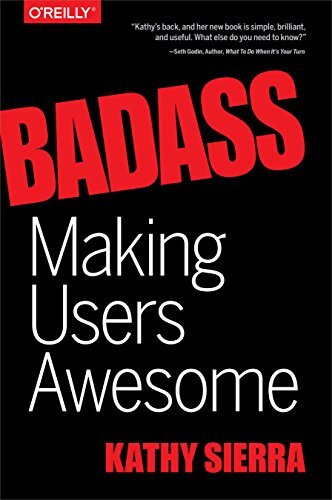
This is one of the best books I’ve read on product design and development. Actually, it’s less of a book and more of a slideshow, with tons of stock photos, diagrams, flow charts, and relatively little text, but the format works, and it conveys the key themes of the book in a clear and memorable way.
In short, if you build products, read this book. It’ll make you a badass.
Here are some of the key takeaways:
Create great users
Your goal is not to create a great product, but to create great users.
- Your product, as well as all the documentation, marketing, and community around it, should be focused on helping the user become a “badass” at something.
- For example, users don’t want to buy a good camera, they want to be great photographers.
- Badass users are the key to successful products because they help the product spread, both through word of mouth (e.g. I love this camera) and through what they are able to do with the product (e.g. look at this amazing photo I took with this camera).
Think through the entire context
That means you need to think about not only the product, but the entire context around it. For example, if your product is a camera, you may also want to:
- Offer photography tutorials, books, and classes
- Put together in-person meetups and online communities where photographers can discuss their craft
- Offer places for photographers to share their work, including online galleries and real-world exhibitions
Market by showing what users can do
This is also how you market the product.
- You don’t show its features.
- You focus on what the person can do with them.
- Apple is very aware of this.
- Their ads for the iPod don’t focus on the amount of disk space or sound quality; they just show people dancing and having fun.
- Their ads for the iPad don’t talk about CPU speeds, memory, or touch screens; they just show grandma doing a video call with her grandchild.
Becoming badass takes time
Becoming “badass” can take a long time, and the beginning of that journey is often very unpleasant.
- For example, when you first start playing the guitar, you sound awful and your fingers hurt; when you first start weightlifting, you’re weak and constantly sore.
- This is called the suck zone.
- Many users give up at this stage and never become badass.
- In part, it’s because they don’t realize that everyone goes through the suck zone, and just assume that they don’t have what it takes to be a badass.
- So one of the keys to a successful product is to clearly, repeatedly, and openly acknowledge that the suck zone is normal and expected.
- Find a way to encourage the user to keep going and provide them with the resources they need to get better, so they can get through the suck zone into the badass zone.
Provide deliberate practice
To help users get better, you have to provide them with the right type of practice (deliberate practice).
- You also have to expose them to a very large quantity of high quality “material”.
- For example, for photographers, you should constantly be showing the user beautiful photos.
- For weightlifters, you should constantly be showing them examples of great technique.
- The book discusses research that shows that by looking at a large number of examples, people can learn new skills astonishingly quickly and completely and unconsciously.
- For example, you can learn to identify the sex of baby chickens just by going through a large number of examples with a mentor, and achieve a high rate of accuracy, but you won’t be able to consciously explain what you’re looking for.
- Similarly, during WWII, airplane spotters learned to identify airplanes at a great distance just by going through a large number of examples with a mentor, achieving high accuracy in a short time period, despite not being able to verbalize how exactly they were doing it.
Quotes
As always, I’ve saved a few of my favorite quotes:
It’s not about our product, our company, our brand. It’s not about how the user feels about us. It’s about how the user feels about himself
Instead of looking for common attributes across successful products we must look for common attributes across successful users of those products.
Users don’t evangelize to their friends because they like a product, they evangelize to their friends because they like their friends.
Don’t just upgrade your product, upgrade your users.
Don’t make a better camera, make a better photographer.
They [customers] stop not because of the struggle. They stop because they don’t realize the struggle is typical and temporary.
What’s much much worse than a bad user manual? Making the user think the manual works just fine for everyone else.
There’s a world of difference between having choices and having to make a choice.
